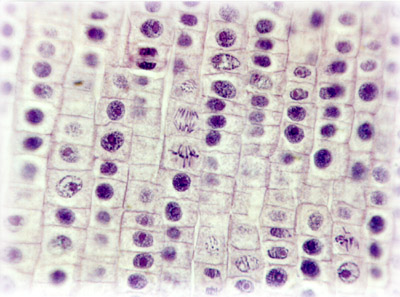MOBILE
MICROSCOPY-UK
MICSCAPE MAGAZINE
Mitosis
by ANNE BRUCE

Various stages of mitosis can be observed in the section above. By looking at several sections, it is possible to identify the sequence of events which makes up the process of mitosis.
In plants, growth occurs in specialised areas called meristems which are situated in the root and shoot tips. Cell division here results in increase in length. Meristem tissue between the phloem and xylem (called cambium) results in increase in the plant's girth.
Mitosis is the mechansim involved in all these processes, it is the type of cell division1 where 2 new cells are produced from a single cell. The two new cells have the same number of chromosomes as the parent cell and are identical to it and to each other.
Multicellular organisms have a huge variety of different types of cell; humans have around 200 different cell types, all of which are derived from a single fertilised egg cell. New cells produced by mitosis differentiate and become specialised. Each cell type has specific genes "switched on" or "switched off" so that it can carry out its particular function.
The following images and the image above showing the process of mitosis were taken from a slide of a longitudinal section through a Broad Bean (Vicia faba) root. The area of cell division is just behind the root tip.

In the "resting" phase the chromosomes are not obvious within the nucleus (above).

Just before cell division starts, a lot of metabolic activity occurs, the chromosomes start to gradually shorten and thicken (above).

Each chromosome has divided to produce 2 identical chromatids, joined at a structure called the centromere. They begin to move towards the equator of the cell (above).

Once at the equator of the cell, the centromeres attach to threads of a spindle structure that has formed. (The spindle spans from one end of the cell to the other). [above]

Contraction of the spindle fibres begins to cause the chromatids to pull apart from one another and move towards opposite ends of the cell (above).

The chromatids separate further. Energy for this is provided by mitochondria (above).

A new nuclear membrane begins to form round the 2 groups of chromatids. A new cell wall begins to be laid down (above).

The chromosomes begin to lengthen and uncoil (above).

Two new cells, identical to each other and to the parent cell. The cells now grow to full size.
(c) Anne Bruce
Abridged from original Micscape article
All rights reserved.
Do not re-use without permission.